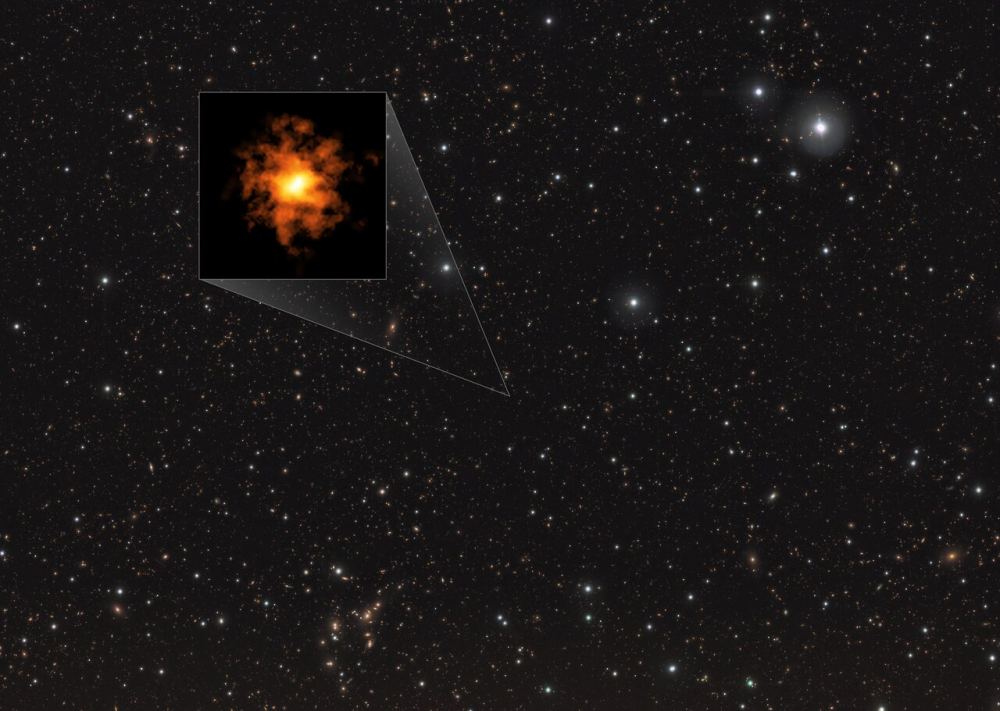The early Universe continues to surprise us, and the latest observations of infant galaxies are no exception. Astronomers have discovered a surprising Milky Way-like galaxy that existed more than 13 billion years ago. It was a time when the universe was really new and galaxies were still in the early stages of formation. It is a bit surprising that such a well-formed form exists in such early history.
The newly discovered galaxy is called REBELS-25. It was discovered as part of the Reionization Era Bright Emission Line Survey (REBELS) using the Atacama Large Millimeter Array (ALMA) in Chile. The goal of this survey is to find and measure early galaxies.
REBELS-24 is a giant disk-shaped galaxy with a spiral arm-like structure. It is very similar to our Milky Way galaxy. It originated over 13 billion years ago and took billions of years to evolve into its current form. Like REBELS-25, the Milky Way began as a lumpy, unorganized protogalaxy shortly after the universe began. It merged with other protogalaxies and evolved into a beautiful spiral shape. It appears to be actively forming stars and is incredibly large for such a young galaxy.
Early spirals are not new
So REBELS-25 poses a big question. Astronomers are trying to find out why the Milky Way was so large and well-evolved when it was still a lump in its infancy. “Our understanding of galaxy formation predicts that most early galaxies will appear small and messy,” says astronomer Jacqueline Hodge of Leiden University in the Netherlands. The fact that REBELS-25 looks so “modern” despite being less than a billion years old, in a way, defies commonly accepted theories about galaxy formation and evolution.
This is not the first time that early spirals have been discovered through astronomical observations. JWST observations suggest that perhaps one-third of early galaxies are already spiral-shaped in the newborn Universe. Its Cosmic Evolution and Early Emission Science Survey (CEERS) discovered many of these during the first 700 million years of the universe’s history. So discovering this almost “modern” looking creature from around 13 billion years ago only adds to the mystery of its formation.
REBELS-25 was discovered through ALMA observations, and hints were also obtained that it has a rotating disk. A series of follow-up observations confirmed the rotation of this galaxy and its spiral arm structure. Additionally, hints of a central bar (just like our Milky Way galaxy has) have been found in the ALMA data. “ALMA is the only telescope in existence with the sensitivity and resolution to achieve this,” said Lenske, a researcher at Liverpool John Moores University in the UK and part of the team working on the discovery. Smit said.

Surprisingly, the ALMA data also suggested a more developed feature similar to the Milky Way. REBELS0-25 has a long, thin rod in the center and appears to have spiral arms. Lucy Roland, a PhD student at Leiden University, said: “Seeing a galaxy so similar to our own Milky Way with its strong rotational dominance is a great example of how galaxies in the early universe could have formed the order of today’s universe. “It calls into question our understanding of how galaxies evolve into certain galaxies.” The university that led the REBELS-25 research. “Finding further evidence of a more evolved structure would be an exciting discovery as this would be the most distant galaxy in which such a structure has been observed to date.”
What does this mean for the evolution of galaxies?
As astronomers discover more of these well-evolved galaxies in the early universe, working models of galaxy birth and evolution will need to be adjusted. In that model, baby galaxies are clumps of stars and gas that come together through collisions or cannibalism to form larger galaxies. It is generally considered a chaotic and turbulent period in the history of the universe. Infant galaxies collided and grew. They combined stars and gas to create larger structures. Over time they begin to rotate, which also affects the formation of structures inside galaxies. Further collisions increase the galaxy’s mass and also promote bursts of star formation. All of this will take billions of years to achieve. Or so astronomers always thought.
REBELS-25 and other early spirals challenge that common model. First, REBELS-25 appears to be a galaxy that is evolving at an accelerated pace. Compared to the Milky Way’s billions of years of evolution, REBELS-25 is moving at warp speed. That means something is causing it to accelerate. What will be important in the future is that we will be able to explain this advanced evolution at a very young age.
The REBELS program should help astronomers understand more about processes occurring just a few hundred million years after the Big Bang. This survey will provide ample data on high-mass galaxies in the early universe. These samples should allow astronomers to use both ALMA and JWST to conduct targeted studies of more galaxies. Both observatories are powerful enough to provide detailed observations of individual galaxies from very early times in the history of the universe.
For more information
Weirdness of the Universe: The most distant spinning disk galaxy discovered (PR)
Strange things about the universe: The most distant spinning disk galaxy discovered (paper)
About REBELS


